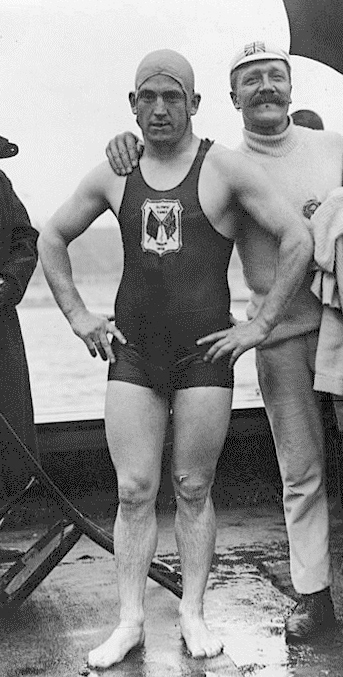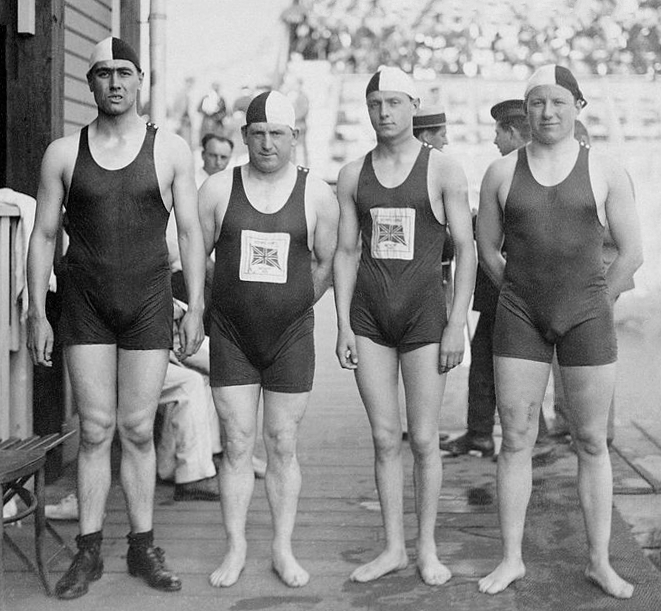1. Overview
Henry Taylor, born on 17 March 1885, was a celebrated English competitive swimmer who represented Great Britain in four Summer Olympics between 1906 and 1920. Despite his remarkable athletic achievements, including winning three gold medals at the 1908 London Olympics-a feat unmatched by any other Briton for a century-Taylor's life after his competitive career was marked by significant financial hardship, culminating in his death in poverty in 1951. His journey from an orphaned child who learned to swim in canals to an Olympic champion, and then to a man forced to sell his medals, reflects a poignant narrative of a national hero whose contributions were not adequately recognized or supported in his later years.
2. Early Life
Henry Taylor's formative years were shaped by early personal loss and a deep connection to water, which would define his future career.
2.1. Childhood and Family
Henry Taylor was born in Hollinwood, Oldham, Lancashire, on 17 March 1885. His parents, James, a coal miner, and Elizabeth Taylor, both passed away when Henry was young. Consequently, he was raised by his older brother, Bill, who would later play a crucial role as his coach.
2.2. Introduction to Swimming and Early Training
Taylor's introduction to swimming began informally in the Hollinwood Canal. He developed his skills by practicing in any available body of water, including public baths, natural streams (becks), canals, and lakes, notably Alexandra Park's boating lake. His friend, Austin Rawlinson, who later became president of the Amateur Swimming Association, recalled Taylor's profound love for swimming above all else. Taylor competed in his first race at the tender age of seven. His brother, Bill, took on the role of his coach, and Taylor trained regularly at the Oldham Baths. From 1894, he also trained at the Chadderton Baths, often utilizing "dirty water days" which offered cheaper admission. Even after securing a job at a cotton mill, Taylor continued his rigorous training, spending his lunch breaks swimming in the canal. Physically, Taylor stood 5.4 ft (1.65 m) tall and weighed approximately 10 lb (10 lb). He notably wore a lightweight, hand-woven silk swimming costume, weighing only about an ounce, during his competitions.
3. Career
Henry Taylor's competitive swimming career spanned over two decades, marked by multiple Olympic appearances and numerous victories, establishing him as one of Britain's most decorated athletes.

3.1. 1906 Intercalated Games
Taylor first gained significant attention following his successes with the Chadderton Swimming Club, which led to his selection for the 1906 Intercalated Games in Athens. Despite not being widely expected to secure medals, he achieved remarkable success. He won a gold medal in the one-mile freestyle event, a silver medal in the 400-meter freestyle, and a bronze medal as part of the 4×250-meter freestyle relay team. His performance in Athens marked a strong international debut. Later that same year, Taylor further solidified his reputation by breaking the world record for the 880 yd distance. His outstanding results ensured his automatic selection for the upcoming 1908 Summer Olympics.
3.2. 1908 London Olympics
The 1908 Summer Olympics in London proved to be the pinnacle of Taylor's career. He participated in three events and won gold medals in all of them: the 400-meter freestyle, the 4×200-meter freestyle relay, and the 1500-meter freestyle. He dominated nearly every race he entered during the Games, with the sole exception of one semi-final. In the 400-meter freestyle semi-final, he finished second to Austrian swimmer Otto Scheff, who had won the same event at the 1906 Intercalated Games. However, in the final, Taylor decisively beat Scheff, finishing a full 10 seconds ahead, with Scheff taking the bronze. The British press lauded Taylor, hailing him as "Britain's Greatest Amateur Swimmer." On 25 July 1908, in London, he became the first man to hold the world record for the 1500-meter freestyle, completing it in a time of 22 minutes and 48.4 seconds. His achievement of three gold medals at a single Olympic Games stood as the most by any Briton for a century, a record only equaled by cyclist Chris Hoy at the 2008 Summer Olympics in Beijing. Tying the medal count of American Mel Sheppard, Taylor was recognized as the most successful athlete at the 1908 Olympics. All three of his victories were achieved with new world records.
3.3. 1912 Stockholm Olympics
Four years later, at the age of 27, Taylor was selected for the 1912 Summer Olympics in Stockholm. Although he was considered past his prime, he still contributed to his team's success, helping them secure a bronze medal in the 4×200-meter freestyle relay. In individual events, he was eliminated in the semi-finals of the 400-meter freestyle and withdrew midway through the semi-finals of the 1500-meter freestyle.

3.4. World War I Service
The 1916 Summer Olympics were canceled due to the outbreak of World War I. Taylor joined the Royal Navy in 1914. To maintain his fitness during his service, he would swim around the ships when his vessel was anchored at Scapa Flow. He was notably present at the Battle of Jutland. A widely circulated, though likely mythical, story recounts that during the battle, his ship, HMS St. Vincent, was supposedly sunk, and Taylor spent two hours swimming around, encouraging his crewmates while awaiting rescue. However, historical records indicate that HMS St. Vincent was not sunk at Jutland. Following his time on HMS St. Vincent, he was transferred to HMS Ramillies, where he remained until his demobilization from service.
3.5. 1920 Antwerp Olympics
After the war, Taylor returned to competitive swimming. His final appearance at the Olympic Games was in Antwerp, Belgium, at the 1920 Summer Olympics. Even at the age of 35, he once again contributed to the 4×200-meter freestyle relay team, helping them win another bronze medal, marking his fourth consecutive Olympic medal in this event. In the individual 400-meter freestyle, he was eliminated in the preliminary heats, and he withdrew midway through the preliminary heats of the 1500-meter freestyle.
3.6. Other Major Competitions and Activities
Taylor continued to swim competitively into his 40s, finally retiring in 1926. Beyond the Olympics, he was a formidable presence in other major competitions. He participated in the Morecambe Bay Race, winning it eight times over a period of 20 years and at one point holding the race record. Taylor also attempted to emulate Matthew Webb by swimming across the English Channel, but adverse weather conditions prevented his success. He annually competed against the French champion in races held in the River Thames and the River Seine, triumphing on every occasion. In addition to swimming, Taylor also played water polo for England. Throughout his illustrious career, he amassed an impressive collection of over 35 trophies and 300 medals.
4. Life After Retirement and Death
Henry Taylor's life after his celebrated swimming career was marked by a stark contrast between his past glory and his later struggles, culminating in a tragic and impoverished end.

4.1. Retirement and Financial Difficulties
Upon his retirement from competitive swimming in 1926, Taylor faced significant financial challenges. He had owned a public house named "The Nudger" in Dobcross, but it was forced to close due to insurmountable financial difficulties. This setback led him to take on a position as an attendant at the Chadderton Baths, where he had once trained. To alleviate his mounting debt and financial distress, Taylor was compelled to sell most of his hard-won prizes and medals, a poignant symbol of his declining fortunes.
4.2. Death
Henry Taylor died in obscurity on 28 February 1951, at the age of 65. He passed away penniless and unmarried, at his lodgings on Brierley Street in Chadderton. His remains were cremated and subsequently scattered at Rochdale Cemetery. His death underscored the unfortunate reality of many athletes of his era, who, despite achieving national and international acclaim, received little long-term financial security or support.
5. Legacy and Assessment
Henry Taylor's enduring legacy is primarily defined by his unparalleled Olympic achievements and his significant impact on British swimming history, which continues to be recognized posthumously.
5.1. Posthumous Honors and Commemoration
Following his death, efforts were made to commemorate Henry Taylor's contributions. The numerous trophies he had won throughout his career were collected and temporarily displayed at the Chadderton Baths. In 1969, he received posthumous recognition with his induction into the International Swimming Hall of Fame, acknowledging his status as one of the sport's greats. Further local commemoration occurred in 2002, when a blue plaque was unveiled at the Chadderton Baths, serving as a permanent tribute to his swimming achievements. At the 2008 Summer Olympics in Beijing, Rebecca Adlington became the first British swimmer since Taylor to win more than one gold medal at a single Olympic Games, drawing a direct comparison to his historic performance in 1908.
5.2. Historical Impact and Comparison
Henry Taylor's historical impact on British swimming is immense. His record of winning three gold medals at a single Olympic Games remained unsurpassed by any other Briton for a full century, highlighting the extraordinary nature of his performance. He was the first man to hold the world record for the 1500-meter freestyle. At the 1908 London Olympics, he was the most successful athlete overall, tying with American runner Mel Sheppard in terms of gold medals won. His achievements set a high bar for future generations of British swimmers and continue to be a benchmark for excellence in the sport.
6. Personal Life
Henry Taylor remained unmarried throughout his life. His final years were characterized by financial hardship, a stark contrast to his earlier sporting glory, culminating in his death in poverty.